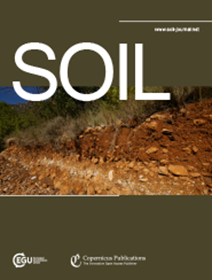Effect of trachyte and basalt powder on the growth and yield of maize (Zea Mays L.) in the Sudano-Sahelian zone of Cameroon (Central Africa)
IF 4.3
2区 农林科学
Q1 SOIL SCIENCE
引用次数: 0
Abstract
Abstract. The Sudano-Sahelian zone of Cameroon, characterized by a low annual rainfall, faces challenges in soil fertility preservation due to agricultural intensification and unsustainable practices. This study aims to evaluate the effect of trachyte and basalt powders inputs on soil and maize yield in Guiring experimental farm. Fieldwork involved collecting and describing samples of trachyte, basalt, and soil and setting up the experimental design. In the laboratory, the ground rock samples underwent geochemical analysis, and the soil samples were analysed for their mineralogical and physicochemical properties. The experiment followed a completely randomized block design with three repetitions and six treatments (T0, T1, T2, T3, T4 and T5). The soil consists of kaolinite, smectite, sepiolite, and quartz. Its texture is dominated by sand fraction, with a neutral pH (6.98). The organic matter (1.30 to 3.17 %) and total nitrogen contents (0.11 to 0.13 %) are relatively low. The concentrations of potassium, magnesium, sodium, and calcium vary from 0.10 to 0.40 cmolc kg-1, 0.72 to 5.44 cmolc kg-1, 0.13 to 0.56 cmolc kg-1, and 2.64 to 6 cmolc kg-1, respectively. The cation exchange capacity is moderate to high, ranging from 18.70 to 25 cmolc kg-1, while the available phosphorus content is high, ranging from 12.60 to 30.30 mg kg-1. The studied soils are moderately suitable for maize cultivation. Fertilization trials showed a significant improvement in maize growth and yield, within plots treated with basalt powder yielding higher (2558.64 kg ha-1 and 2931.16 kg ha-1) than those treated with trachyte powder (2362.87 kg ha-1and 2763.91 kg ha-1) and the control plots (645.83 kg ha-1). Plots treated with NPK fertilizer recorded the highest yield (3164.45 kg ha-1). Although the treatment with conventional fertiliser resulted in a relative higher yield, the advantage of using rock powders lies in their environmental benefits, long-term effectiveness, and more affordable cost.粗叶菌和玄武岩粉对喀麦隆(中非)苏丹-萨赫勒地区玉米生长和产量的影响
摘要。喀麦隆的苏丹-萨赫勒地区的特点是年降雨量少,由于农业集约化和不可持续的做法,在土壤肥力保持方面面临挑战。本研究旨在评价粗叶菌粉和玄武岩粉投入量对桂陵试验田土壤和玉米产量的影响。野外工作包括收集和描述粗面岩、玄武岩和土壤样品,并建立实验设计。在实验室中,对地面岩石样品进行了地球化学分析,对土壤样品进行了矿物学和理化性质分析。试验采用完全随机区组设计,3个重复,6个处理(T0、T1、T2、T3、T4和T5)。土壤由高岭石、蒙脱石、海泡石和石英组成。其质地以砂粒为主,pH为中性(6.98)。有机质含量(1.30 ~ 3.17%)和全氮含量(0.11 ~ 0.13%)较低。钾、镁、钠和钙的浓度分别为0.10至0.40、0.72至5.44、0.13至0.56和2.64至6 cmolc kg-1。阳离子交换容量中高,在18.70 ~ 25 cmolc kg-1之间,有效磷含量高,在12.60 ~ 30.30 mg kg-1之间。所研究的土壤适宜种植玉米。施肥试验表明,玄武岩粉处理的玉米产量(2558.64 kg ha-1和2931.16 kg ha-1)显著高于粗叶菌粉处理(2362.87 kg ha-1和2763.91 kg ha-1)和对照(645.83 kg ha-1)。施用氮磷钾的地块产量最高(3164.45 kg hm -1)。虽然用常规肥料处理导致相对较高的产量,但使用岩石粉的优势在于其环境效益,长期有效性和更实惠的成本。
本文章由计算机程序翻译,如有差异,请以英文原文为准。
求助全文
约1分钟内获得全文
求助全文
来源期刊

Soil
Agricultural and Biological Sciences-Soil Science
CiteScore
10.80
自引率
2.90%
发文量
44
审稿时长
30 weeks
期刊介绍:
SOIL is an international scientific journal dedicated to the publication and discussion of high-quality research in the field of soil system sciences.
SOIL is at the interface between the atmosphere, lithosphere, hydrosphere, and biosphere. SOIL publishes scientific research that contributes to understanding the soil system and its interaction with humans and the entire Earth system. The scope of the journal includes all topics that fall within the study of soil science as a discipline, with an emphasis on studies that integrate soil science with other sciences (hydrology, agronomy, socio-economics, health sciences, atmospheric sciences, etc.).
 求助内容:
求助内容: 应助结果提醒方式:
应助结果提醒方式:


